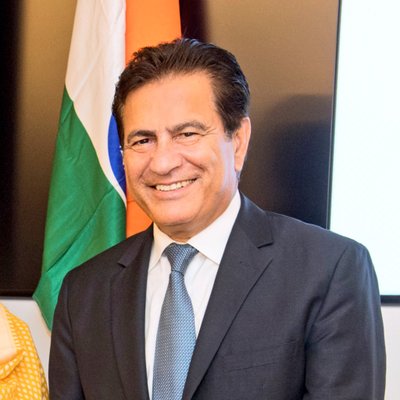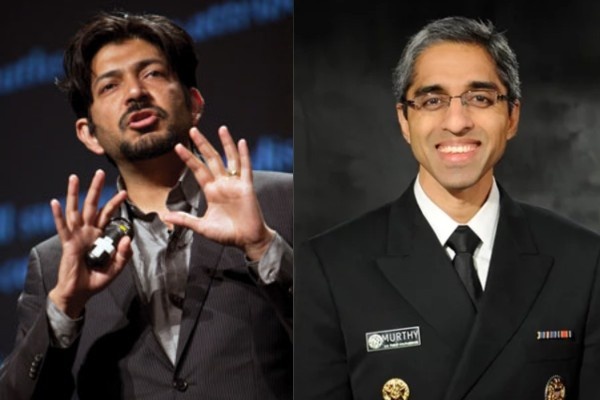पीएम मोदी की न्यूयॉर्क यात्रा से क्वाड पर बढ़ेगा फोकस
मोदी की यात्रा 21 सितंबर को क्वाड लीडर्स की चौथी समिट से शुरू होगी। उनके अन्य कार्यक्रमों में न्यूयॉर्क में समिट फॉर द फ्यूचर में संबोधन, वैश्विक ग्लोबल सीईओज़ के साथ बैठकें, प्रवासी भारतीयों से बातचीत और अंतर्राष्ट्रीय नेताओं के साथ द्विपक्षीय वार्ताएं शामिल हैं।
.jpg) 2024 में क्वाड की 20वीं वर्षगांठ है। यह समूह अब 35 ट्रिलियन डॉलर की इकोनमी वाला ग्रुप बन चुका है। / image- X/@narendramodi
2024 में क्वाड की 20वीं वर्षगांठ है। यह समूह अब 35 ट्रिलियन डॉलर की इकोनमी वाला ग्रुप बन चुका है। / image- X/@narendramodi
भारत के प्रधानमंत्री नरेंद्र मोदी संयुक्त राष्ट्र महासभा (यूएनजीए) के 79वें सत्र में हिस्सा लेने के लिए 21 से 23 सितंबर तक अमेरिका के न्यूयॉर्क में रहेंगे। तीसरी बार प्रधानमंत्री बनने के बाद मोदी की यह पहली अमेरिका यात्रा है।
प्रधानमंत्री मोदी 22 सितंबर को न्यूयॉर्क के लॉन्ग आइलैंड में भारतीय समुदाय की विशाल सभा को संबोधित करेंगे। यह संबोधन 2014 में मैडिसन स्क्वायर गार्डन में पीएम मोदी के प्रतिष्ठित भाषण के एक दशक होने जा रहा है। उसी संबोधन ने दुनिया के कोने कोने में बसे भारतीय डायस्पोरा के सदस्यों को प्रधानमंत्री के वक्तृत्व कौशल का मुरीद बनाना शुरू किया था।
प्रधानमंत्री मोदी की वर्तमान यात्रा 21 सितंबर को राष्ट्रपति बाइडन के गृह राज्य विलमिंगटन डेलावेयर में बहुप्रतीक्षित क्वाड लीडर्स की चौथी समिट से शुरू होगी। उनके अन्य कार्यक्रमों में न्यूयॉर्क शहर में समिट फॉर द फ्यूचर में संबोधन, वैश्विक ग्लोबल सीईओज़ के साथ बैठकें, प्रवासी भारतीयों से बातचीत और अंतर्राष्ट्रीय नेताओं के साथ द्विपक्षीय वार्ताएं शामिल हैं।
यह यात्रा रणनीतिक साझेदारी को मजबूत करने के लिहाज से महत्वपूर्ण होगी। साल 2023 ने अमेरिका-भारत के बीच राजकीय यात्राओं के इतिहास में एक बहुत ही उच्च मानदंड स्थापित किया है। यह वाशिंगटन डीसी में किसी भारतीय नेता की केवल तीसरी राजकीय यात्रा थी। राजकीय यात्रा ने नए क्षेत्रों में अमेरिका-भारत संबंधों को गति दी है। प्रधानमंत्री मोदी और राष्ट्रपति बाइडेन दोनों ने भारत में GE F-414 जेट इंजन के निर्माण जैसी संयुक्त परियोजनाओं के अलावा स्वच्छ ऊर्जा, शिक्षा, अंतरिक्ष, सेमीकंडक्टर, क्वांटम कंप्यूटिंग, ड्रोन टेक्नोलोजी, एआई जैसे क्षेत्रों में ठोस रणनीतिक रोडमैप के साथ संवाद और पहल का नया मार्ग प्रशस्त किया है। इसने भारत को ऐसी मैन्यूफैक्चरिंग क्षमता वाले देशों के विशिष्ट क्लब में लाकर खड़ा कर दिया है।
इस राजकीय यात्रा ने महत्वपूर्ण और उभरती टेक्नोलोजी के नए क्षेत्र जैसे कि क्रिटिकल एंड एमर्जिंग टेक्नोलोजी (iCET) और भारत-अमेरिका डिफेंस एक्सेलेरेशन इकोसिस्टम (INDUS-X) में भी गहन सहयोग को बल दिया है। INDUS-X भारतीय रक्षा मंत्रालय (MoD) और अमेरिकी रक्षा विभाग (DoD) की संयुक्त पहल है।
हाल ही में संपन्न इंडस-एक्स का तीसरा संस्करण शानदार रहा था। इसमें USISPF ने दोनों सरकारों और स्टैनफोर्ड के गॉर्डियन नॉट सेंटर और हूवर इंस्टीट्यूशन के साथ साझेदारी की। इस दौरान वाशिंगटन और नई दिल्ली के प्रमुख रक्षा नीति निर्माताओं ने दो सबसे जीवंत लोकतंत्रों के बीच रक्षा संबंधों को मजबूत करने और स्टार्टअप्स, तकनीकी दिग्गजों, कुलपतियों व शिक्षाविदों को हितधारी संबंधों तक लाने वाले प्रौद्योगिकी संबंधों को आगे बढ़ाने पर चर्चा की।
2024 में क्वाड की 20वीं वर्षगांठ है। इसकी शुरुआत हिंद महासागर में सुनामी के बाद राहत कार्यों को पूरा करने के लिए बने एक अस्पष्ट समूह से हुई थी। लेकिन अब यह समूह 35 ट्रिलियन डॉलर की इकोनमी वाला ग्रुप बन चुका है, जो सुरक्षा सहयोग, बहुपक्षीय कूटनीति, इंडो-पैसिफिक क्षेत्र के अंदर आर्थिक राहत के लिए समर्पित है।
2024 में भारत को क्वाड शिखर सम्मेलन की मेजबानी करनी थी। लेकिन भारत में अप्रैल से जून तक और अमेरिका में नवंबर में होने वाले चुनावों की वजह से तारीख बदलनी पड़ी। अब भारत अगले साल क्वाड शिखर सम्मेलन की मेजबानी करेगा।
क्वाड का यह आगामी शिखर सम्मेलन कुछ हटकर होगा। क्वाड की पहली इन-पर्सन प्रिंसिपल-लेवल समिट 2021 में वाशिंगटन में हुई थी। उस समय दुनिया कोरोना महामारी के उग्र रूप से जूझ रही थी। चूंकि राष्ट्रपति बाइडेन और प्रधानमंत्री किशिदा फिर से चुनाव लड़ने पर जोर नहीं दे रहे हैं, ऐसे में प्रधानमंत्री मोदी जल्द ही इकलौते ऐसे नेता बन जाएंगे जो क्वाड नेताओं की समिट की शुरुआत के बाद से अगले साल होने वाले समिट में मौजूद चार नेताओं में से शामिल होंगे।
अगले वर्ष के शिखर सम्मेलन का एजेंडा क्वाड की प्रगति की समीक्षा करना और उस दृष्टिकोण को निर्धारित करना होगा जिसे चारों देश न केवल अपने लोकतंत्रों के लिए बल्कि भारत-प्रशांत व्यापक क्षेत्र के अन्य देशों के लिए हासिल करना चाहते हैं। शिखर सम्मेलन क्षेत्रीय सुरक्षा, भारत-प्रशांत रणनीति और वैश्विक कूटनीति में बदलते रुझानों पर केंद्रित होगा। भू-राजनीतिक और सुरक्षा से जुड़े मुद्दों के इतर, इस दौरान एआई, क्वांटम सेमीकंडक्टर्स, जैव प्रौद्योगिकी और साइबर टेक्नोलोजी में गहन सहयोग के अवसरों का पता लगाने पर भी चर्चा होगी। यह सहयोग इंडस-एक्स में हुई हालिया नीतिगत चर्चाओं से बने संबंधों को और मजबूती प्रदान करेगा।
जलवायु संबंधी मुद्दों की अहमियत के कारण ऊर्जा सुरक्षा, उत्सर्जन में कटौती, उभरती अर्थव्यवस्थाओं के लिए सुरक्षित क्लाइमेट फंडिंग और ग्लोबल साउथ के लिए ग्रीन इकोनमी बनाने की बेहद जरूरत है। ऐसे में क्वाड में सुरक्षा एवं तकनीकी संवादों के साथ ही जलवायु एजेंडा को भी प्राथमिकता दी जाएगी। ऐसा इसलिए क्योंकि बुनियादी ढांचे और डेवलपमेंट फाइनेंस के लिए सर्वसम्मति से तैयार दृष्टिकोण आवश्यक है।
पिछले एक दशक में वाशिंगटन के नीति निर्माताओं के रूप में एक ईमानदार बदलाव आया है। पहले वे ट्रांस अटलांटिक संबंधों पर अधिक फोकस करते थे, लेकिन अब इंडो-पैसिफिक और तटीय राज्यों को प्राथमिकता दे रहे हैं। हमने ट्रम्प सरकार के दौरान इंडो-पैसिफिक को प्राथमिकता देते हुए देखा था, राष्ट्रपति बाइडेन के कार्यकाल में इसे और अधिक तवज्जो मिली। प्रेसिडेंट बाइडेन ने ही पहला इन-पर्सन क्वाड लीडर्स समिट बुलाया था। जनवरी 2025 में व्हाइट हाउस में कोई भी आए, इसकी चिंता किए बिना इंडो-पैसिफिक का मुद्दा न केवल प्रमुख रहेगा बल्कि अमेरिका की राष्ट्रीय सुरक्षा संबंधी फैसलों के केंद्र में भी होगा।
दक्षिण चीन सागर में बीजिंग का अड़ियल रवैया न केवल तटवर्ती राज्यों के लिए खतरा है बल्कि पूर्वी चीन सागर में चीन द्वारा तैयार उथल पुथल भरे माहौल के लिए भी महत्वपूर्ण है। ये ताइवान की सुरक्षा और अगली पीढ़ी की तकनीक के लिए अहम सेमीकंडक्टर सप्लाई चेन दोनों को प्रभावित करती है।
अमेरिका और भारत दोनों ही क्वाड समिट का इस्तेमाल भारतीय रक्षा मंत्री, राजनाथ सिंह की अमेरिका यात्रा के लक्ष्यों को आगे बढ़ाने पर केंद्रित करेंगे। मोदी 3.0 में भारत के किसी कैबिनेट मंत्री की यह पहली अमेरिका यात्रा थी। इस दौरान राजनाथ की अमेरिकी रक्षा मंत्री लॉयड ऑस्टिन व अमेरिकी राष्ट्रीय सुरक्षा सलाहकार जेक सुलिवन के साथ बैठकों ने सिक्योरिटी ऑफ सप्लाई अरेंजमेंट (S.O.S.A.) समझौते का रास्ता साफ किया था। यह समझौता लचीली आपूर्ति श्रृंखलाओं को मजबूत बनाने के लिहाज से महत्वपूर्ण है।
यह राष्ट्रपति बाइडेन की आखिरी व्यक्तिगत क्वाड लीडर्स समिट होगी, लेकिन उनका उत्तराधिकारी चाहे कोई भी हो, दोनों दलों के बीच एक मजबूत दृष्टिकोण बना हुआ है, जिसमें वाशिंगटन नई दिल्ली, कैनबरा और टोक्यो मिलकर काम करते रहेंगे और निष्पक्ष व निर्बाध इंडो-पैसिफिक का लक्ष्य हासिल करने के लिए मजबूती से आगे बढ़ते रहेंगे।

 Mukesh Aghi
Mukesh Aghi












.jpg)

Comments
Start the conversation
Become a member of New India Abroad to start commenting.
Sign Up Now
Already have an account? Login